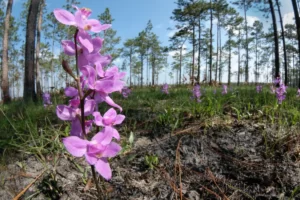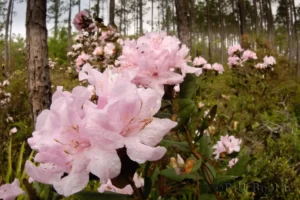We live on a street in a rural community which probably resembles most towns in the United States where most of the yards resemble square patches of solid green grass with not much else, not even trees. On the weekends and in the cool of the evenings or mornings, the homeowners or their gardeners venture out with their noisy beasts that belch fumes of gas to spend their precious time to mow their expanse of grass.
When giving directions to our house, we tell visitors, “Just look for the only house with trees in its yard.” I know that our neighbors look at our yard full of weeds and unruly shrubs with disbelief, thinking why don’t we “clean up” our messy yard. Instead of having to mow several times a week, we only have to mow occasionally. We use our gained time to enjoy observing nature in our own yard. Every time we go outside, we see hummingbirds, butterflies, bees, and other insects foraging on the native species that we allow to exist. It is rare that we don’t see something interesting in our yard when we go outside. In fact, many of the photos on this website were taken in our back yard.


This is our messy yard in 2010 with numerous native species and much less lawn. Our yard may be “messy,” but it is full of birds, butterflies, and other insects.
By not having a grass monoculture, we save money by not having to pay for gasoline for the mower which is a huge polluter; we don’t have to waste water to keep the grass green; we don’t have to use chemical fertilizer since the trees’ leaves provide ready-made compost; we don’t add yard waste to the landfill; and we personally don’t ever use pesticides since the insects in our miniature ecosytem are kept in check by their natural predators.
Most critically, we are providing a needed ecosystem for the flora and fauna that are increasingly dependent on natural landscapes as the surrounding habitats are being developed. This premise is presented eloquently by Bringing Nature Home: How You Can Sustain Wildlife with Native Plants, Updated and Expanded by Douglas W. Tallamy, 2009, Timber Press.
I read the following satire back in the 1980s and it says it all.
“Winterize your lawn”, the big sign outside the garden store commanded. I’ve fed it, watered it, mowed it, raked it and watched a lot of it die anyway. Now I’m supposed to winterize it? I hope it’s too late. Grass lawns have to be the stupidest thing we’ve come up with outside of thong swimsuits!
We constantly battle dandelions, Queen Anne’s lace, thistle, violets, chicory and clover that thrive naturally, so we can grow grass that must be nursed through an annual four-step chemical dependency.
Imagine the conversation The Creator might have with St Francis about this:
“Frank, you know all about gardens and nature. What in the world is going on down there in the Midwest? What happened to the dandelions, violets, thistle and stuff I started eons ago? I had a perfect, no-maintenance garden plan. Those plants grow in any the of soil, withstand drought and multiply with abandon. The nectar from the long-lasting blossoms attracted butterflies, honey bees and flocks of songbirds. I expected to see a vast garden of colors by now. But all I see are these green rectangles.”
“It’s the tribes that settled there, Lord. The Suburbanites. They started calling your flowers “weeds” and went to great extent to kill them and replace them with grass. “Grass? But it’s so boring. It’s not colorful. It doesn’t attract butterflies, birds and bees, only grubs and sod worms. It’s temperamental with temperatures. Do these Suburbanites really want all that grass growing there?”
“Apparently so, Lord. They go to great pains to grow it and keep it green. They begin each spring by fertilizing grass and poisoning any other plant that crops up in the lawn.”
“The spring rains and cool weather probably make grass grow really fast. That must make the Suburbanites happy.”
“Apparently not, Lord. As soon as it grows a little, they cut it – sometimes twice a week.”
“They cut it? Do they then bale it like hay?”
“Not exactly, Lord. Most of them rake it up and put it in bags.”
“They bag it? Why? Is it a cash crop? Do they sell it?”
“No, sir. Just the opposite. They pay to throw it away.”
“Now let me get this straight. They fertilize grass so it will grow. And when it does grow, they cut it off and pay to throw it away?”
“Yes, Sir.”
“These Suburbanites must be relieved in the summer when we cut back on the rain and turn up the heat. That slows the growth and saves them a lot of work.”
“You aren’t going to believe this Lord. When the grass stops growing so fast, they drag out hoses and pay more money to water it so they can continue to mow it and pay to get rid of it.”
“What nonsense! At least they kept some of the trees. The trees grow leaves in the spring to provide beauty and shade in the summer. In the autumn they fall to the ground and form a natural blanket to keep moisture in the soil and protect the trees and bushes. Plus, as they rot, the leaves form compost to enhance the soil. It’s a natural circle of life.”
“You better sit down, Lord. The Suburbanites have drawn a new circle. As soon as the leaves fall, they rake them into great piles and have them hauled away.”
“No! What do they do to protect the shrub and tree roots in the winter and keep the soil moist and loose?”
“After throwing away your leaves, they go out and buy something they call mulch. They haul it home and spread it around in place of the leaves.”
“And where do they get this mulch?”
“They cut down trees and grind them up.”
Image Slider
Image Carousel



